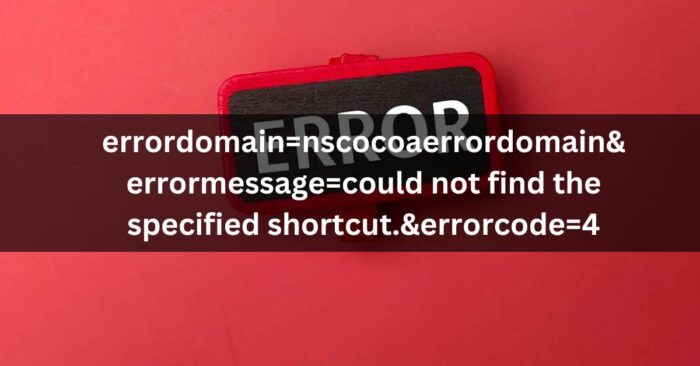errordomain=nscocoaerrordomain&errormessage=could not find the specified shortcut.&errorcode=4

Error Message Decoded: NSCocoaErrorDomain and the Missing Shortcut Navigating through the labyrinth of error messages while working on macOS can be daunting, especially when the error seems cryptic at first glance. The error: errordomain=nscocoaerrordomain&errormessage=could not find the specified shortcut.&errorcode=4 is a frequent source of frustration for many developers. This mistake may prevent you from moving forward and leave you perplexed about what went wrong. We’ll break down this message, identify its elements, and offer doable fixes in this piece to help you get back on track.
Understanding NSCocoaErrorDomain
NSCocoaErrorDomain is a vital identifier in macOS and iOS development, denoting errors within the expansive Cocoa framework. This framework, integral to the development of applications on Apple’s platforms, comprises a vast collection of APIs, providing the tools necessary for building the graphical interface, working with data, and performing system operations. When an error is flagged under this domain, it signifies an issue specifically tied to these Cocoa-based operations or functionalities.
Categorized under NSCocoaErrorDomain, it not only pinpoints the concern in development but aids focused troubleshooting. Recognizing an error as part of this domain is the first step in narrowing down the vast field of potential issues, directing developers towards the relevant sections of their code or aspects of the Cocoa framework that may be the source of the problem.
Error Message Breakdown
Dissecting the error message provides direct insight into the system’s communication, revealing issues with locating specified shortcuts. This specific message is alerting us that an action involving a shortcut has failed within the scope of the Cocoa framework, designated by ‘errordomain=nscocoaerrordomain’. The core message, ‘errormessage=could not find the specified shortcut.’, pinpoints the issue—the system can’t locate the expected shortcut.
The problem is quantified and categorized as ‘errordomain=nscocoaerrordomain&errormessage=could not find the specified shortcut.&errorcode=4,’ uniquely identifying this type of NSCocoaErrorDomain error. By understanding the structured format of this error message, developers are better equipped to commence troubleshooting efforts, focusing on the specific area of failure—the missing shortcut. This targeted approach streamlines the resolution process, swiftly identifying the missing element or misconfiguration causing disruption in behavior.
Deciphering the Error Message Components
Tackling error intricacies requires breaking down components to pinpoint issues and find resolutions effectively. The ‘errordomain’ is indicative of the Cocoa framework being the context within which the error has arisen, guiding developers to focus their attention on this specific area. The ‘errormessage’ component, elucidating the nature of the problem as the system’s inability to find a designated shortcut, acts as a direct indicator of what needs to be addressed.
The ‘errorcode’ provides a valuable numerical identifier, error code 4, facilitating reference to specific NSCocoaErrorDomain documentation or troubleshooting guides. Dissecting these elements provides developers with clarity on the error’s context, the specific issue, and a starting point for solutions. This analytical approach streamlines the troubleshooting process, directing efforts towards rectifying the absence or misidentification of the expected shortcut, thereby facilitating a more structured and efficient path to resolution.
Reasons for Shortcut Failure
Several factors could trigger the occurrence of the shortcut failure error within the NSCocoaErrorDomain. Commonly, an incorrect shortcut path results from typos or misunderstanding the expected file structure specifications. Additionally, the shortcut may no longer exist in the designated location due to deletion or relocation, rendering the path invalid. Another potential reason is permission issues, where the application lacks the necessary access rights to interact with the shortcut, a scenario often overlooked during initial development phases.
Operating system updates or security setting changes may inadvertently impact the application’s ability to use shortcuts as intended. Diagnosing the specific cause requires a close examination of the application’s configuration, the state of the file system, and the operating environment to identify and rectify the mismatch or oversight leading to this error.
Common Causes for Missing Shortcut Errors
Navigating the root causes of missing shortcut errors within the Errordomain=nscocoaerrordomain&errormessage=could not find the specified shortcut.&errorcode=4 is essential for effective troubleshooting. Among the prevalent reasons, incorrect path specifications stand out. Occurs with a mismatch between expected and actual shortcut paths, often due to typos or directory structure changes. Misconfiguration in the application’s code can also lead to these errors, especially if there has been an oversight in specifying the correct path or if the shortcut was inadvertently removed during updates or changes in the development environment.
Additionally, permission restrictions play a significant role. If the application or the executing process does not have the requisite permissions to access or execute the shortcut, the system will fail to find or utilize the shortcut as intended. Environmental changes, such as system updates or modifications in security settings, might also render previously functional shortcuts inaccessible or missing. When a missing shortcut arises, developers can troubleshoot effectively by recognizing typical causes and focusing efforts accordingly.
Step-by-Step Guide to Troubleshooting
To ensure the accuracy and accessibility of the shortcut, start the debugging procedure by looking at its path. Misplaced or inaccessible shortcuts due to incorrect path specification are common causes of this error. Consider recent changes like system updates or application modifications that may influence the shortcut’s functionality. These changes can sometimes disrupt the expected behavior or accessibility of shortcuts. Proceed by checking the application’s permissions to ensure it has the necessary rights to access and execute the shortcut.
Insufficient permissions are often overlooked but can prevent the application from finding or utilizing the shortcut. If the issue remains unresolved after these steps, delve into the application’s code. Look for potential bugs or misconfigurations related to shortcut management. Debugging tools and code review can be particularly helpful in identifying and rectifying such issues. Throughout this process, keep detailed notes on any changes made and their effects, to help isolate the cause of the error. This methodical approach facilitates a thorough investigation of the problem, enabling a targeted resolution strategy.
Preventing Shortcut-Related Errors in Future Projects
Minimizing the incidence of shortcut-related errors in subsequent projects requires a proactive and meticulous approach. One effective strategy is to establish a protocol for rigorous testing of all shortcut functionalities before deployment. Include periodic retesting post updates to catch and correct issues disrupting shortcut paths or functionalities, ensuring stability. Keeping comprehensive documentation on the configurations of shortcuts, including their paths and any required permissions, is crucial. Regularly updating this documentation to reflect any changes ensures that all team members have access to accurate information.
Developers must stay updated on Cocoa framework and macOS changes, as updates may impact shortcut management and access. Implementing a system for monitoring the application’s interaction with shortcuts can also be beneficial. This might include logging shortcut access attempts and failures, which can provide early warnings of potential issues. By incorporating these strategies into the development workflow, teams can significantly reduce the risk of encountering shortcut-related errors, leading to smoother project progress and a more reliable end product.
Additional Resources and Tools
Exploring Errordomain=nscocoaerrordomain&errormessage=could not find the specified shortcut.&errorcode=4 specifics for resolving missing shortcut issues? Numerous tools and resources are available for assistance. Apple’s developer documentation serves as a cornerstone, offering comprehensive insights into the Cocoa framework and its error reporting mechanisms. It’s a prime starting point for understanding the nuances of error code 4 and its implications within your development projects. Additionally, leveraging Xcode’s debugger provides a hands-on approach to identifying where and why a shortcut might be missing.
Through breakpoints and console logs, developers can trace the execution flow, revealing critical insights into the error’s origin. The Console.app further complements these efforts, offering a way to monitor system and application logs in real-time. This tool is particularly useful for catching elusive errors that occur during specific interactions with the operating system. Integrate resources into your troubleshooting workflow for swift and accurate resolution of shortcut-related issues, ensuring smoother development and deployment.
Best Practices for Handling Shortcut Errors
To mitigate and manage shortcut errors efficiently, developers should prioritize comprehensive code reviews. Such reviews, conducted regularly, can preemptively identify potential pitfalls related to shortcut management before they escalate into more significant problems. Integrating robust error handling mechanisms is another critical strategy. Prepare your application to handle shortcut errors gracefully for a smoother user experience and easier debugging. Extensive testing plays a pivotal role as well; this includes not only initial tests but also ongoing tests to cover any updates or environmental changes that might affect shortcut functionality.
Automated tests for shortcut features offer effective continuous oversight and prompt feedback on emerging issues. Encourage team members to stay informed about Cocoa framework and macOS updates for proactive identification and resolution of shortcut errors. This knowledge enables developers to anticipate and adapt to changes that might impact shortcut behavior, ensuring that applications remain functional and reliable through updates and modifications to their operating environment.
FAQs
Q: What does the errordomain=nscocoaerrordomain&errormessage=could not find the specified shortcut.&errorcode=4 signify with the message “Could not find the specified shortcut”?
A: Error code 4 in NSCocoaErrorDomain indicates that the system encountered an issue related to the Cocoa framework on Apple’s platforms. The accompanying message “Could not find the specified shortcut” suggests that there’s a problem locating or accessing the designated shortcut.
Q: How do I interpret the error message “Could not find the specified shortcut” in NSCocoaErrorDomain?
A: The error message implies that the system failed to locate a shortcut as specified. Possible causes: a missing file, misconfigured shortcut, or changes in application or system settings affecting accessibility.
Q: Can I resolve the NSCocoaErrorDomain error with ErrorCode 4 on my own?
A: Try resolving by verifying the existence and correctness of the associated file or action for the shortcut. Check application settings for the shortcut and ensure they are configured correctly. Additionally, consider updating the application or checking for any patches addressing compatibility issues.
Q: Are there common reasons for encountering NSCocoaErrorDomain with ErrorCode 4 and the message “Could not find the specified shortcut”?
A: Common causes: corrupted or missing shortcut file, system configuration changes, or application updates affecting shortcut functionality. It’s advisable to review recent changes to the system or application to pinpoint potential triggers.
Q: Should I contact support if NSCocoaErrorDomain with ErrorCode 4 persists despite troubleshooting?
A: If the issue persists after troubleshooting, contact the application or platform support (Apple) for assistance. They offer specific help, addressing bugs or suggesting workarounds for NSCocoaErrorDomain with ErrorCode 4 and its error message.
Conclusion
Navigating NSCocoaErrorDomain errors, especially regarding missing shortcuts, may initially appear as a challenging task. However, breaking down the error into its constituent parts, employing strategic troubleshooting methods, and incorporating preventative measures can transform this challenge into a manageable task. Address NSCocoaErrorDomain issues with technical expertise and a systematic approach, emphasizing root cause identification and practical solutions.
Tackling error code 4 for missing shortcuts emphasizes detailed documentation, rigorous testing, and continual learning in Cocoa framework. By accepting these mistakes as teaching moments, developers can improve their ability to solve problems and create more dependable, user-friendly software. Developers can not only remedy current issues but also fortify their projects against future mistakes by applying the insights and techniques presented. This proactive approach will result in more efficient project management and a better final outcome.
errordomain=nscocoaerrordomain&errormessage=could not find the specified shortcut.&errorcode=4



